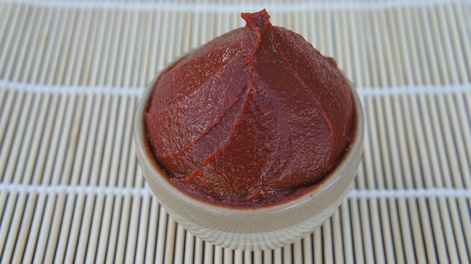We now know that miso is a finished product that has undergone double fermentation.
During the first fermentation, filamentous fungi surround the seeds in the "Koji" and mainly produce:
- Amylolytic, proteolytic and lipolytic enzymes;
- Vitamins (thiamine, riboflavin, vitamin B6, pantothenic acid...);
- Growth factors;
- Glutamic acid (transformation of glutamine by a glutaminase).
The second fermentation at the "Miso" stage generates :
- All essential amino acids;
- All the B vitamins ;
- Lots of lactobacilli;
- Additional enzymes.
Studies in progress...
Dr. Akizuki's studies had highlighted the protective action against radiation of the "Miso soup " composed of Miso and Wakame.
Further research by Japanese researcher Hiromitsu Watanabe on mice was published in 2013. This scientist evaluated the protective effects of different types of seeds (soybeans, rice, barley) and different types of "Misos " more or less fermented vis-à-vis ionizing radiation.
He sought to understand the source of the radioprotective properties of "Miso". Did they come directly from one of its components? From the combination of several of them? Or from the fermentation of different components?
The conclusions he reaches are very clear: "The radioprotective mechanism of "Miso" is closely related to the substances produced during the fermentation step."
It is therefore the bacteria present in the "Miso" that generate substances with radioprotective effects, among them, cytokines.
The best known cytokine is interferon. These are soluble substances produced by the immune system. They play a role in cell signaling and can be delivered by other pathways.
Hiromitsu Watanabe explains, "The cytokines in 'Miso' may theoretically play an important role in the protection and/or recovery or regeneration of affected tissues when administered prior to and during irradiation."
In his book "The Cancer Prevention Diet: the Macrobiotic Approach to Cancer Prevention and Healing," Michio Kushi tells the story of a woman who used the "Miso " along with a macrobiotic diet to survive the direct radiation she was exposed to during an atomic bomb blast.

Radioprotective foods and radiation therapy for cancer
The exceptional radioprotective properties of the "Miso " towards direct ionizing radiation made us think that they could perhaps be used to protect patients undergoing radiotherapy treatments during cancer.
However, other studies point in the same direction as those mentioned above. One of them is entitled "Radiation protection of lung tissue by soy isoflavones". Experiments using unfermented soybeans demonstrate that soy isoflavones or flavonoids improve the effectiveness of radiation on lung tumor nodules while simultaneously protecting the healthy lung from radiation injury. After fermentation, as is the case for "Miso " for example, these isoflavones still present further increase radiation protection from radiotherapy.
There are several interesting conclusions to be drawn from these studies:
- Unfermented soy isoflavones ingested before and after radiation treatment protect healthy (lung) cells from radiation damage.
- positive effects were also observed in skin injuries, hair loss, breathing frequency, inflammation, lung disease and fibrosis: all of which reinforce the evidence for soy's radioprotective effects.
The effects of "Miso " during radiation therapy:
- Soy seems to increase the toxicity of the radiation that affects cancer cells and therefore the effectiveness of this type of treatment.
- it protects healthy cells against all types of irradiation.
- it potentiates the destructive effect of radiation on cancer cells.
Despite indisputable scientific publications, many oncologists still tend to dismiss the properties of "Miso ".



